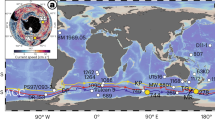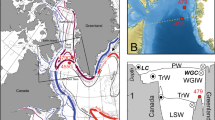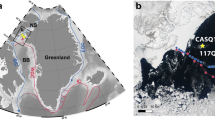Abstract
The early oceanographic history of the Arctic Ocean is important in regulating, and responding to, climatic changes. However, constraints on its oceanographic history preceding the Quaternary (the past 1.8 Myr) have become available only recently, because of the difficulties associated with obtaining continuous sediment records in such a hostile setting. Here, we use the neodymium isotope compositions of two sediment cores recovered near the North Pole to reconstruct over the past ∼15 Myr the sources contributing to Arctic Intermediate Water, a water mass found today at depths of 200 to 1,500 m. We interpret high neodymium ratios for the period between 15 and 2 Myr ago, and for the glacial periods thereafter, as indicative of weathering input from the Siberian Putoranan basalts into the Arctic Ocean. Arctic Intermediate Water was then derived from brine formation in the Eurasian shelf regions, with only a limited contribution of intermediate water from the North Atlantic. In contrast, the modern circulation pattern, with relatively high contributions of North Atlantic Intermediate Water and negligible input from brine formation, exhibits low neodymium isotope ratios and is typical for the interglacial periods of the past 2 Myr. We suggest that changes in climatic conditions and the tectonic setting were responsible for switches between these two modes.
This is a preview of subscription content, access via your institution
Access options
Subscribe to this journal
Receive 12 print issues and online access
$259.00 per year
only $21.58 per issue
Buy this article
- Purchase on Springer Link
- Instant access to full article PDF
Prices may be subject to local taxes which are calculated during checkout



Similar content being viewed by others
References
Peterson, B. J. et al. Trajectory shifts in the Arctic and Subarctic freshwater cycle. Science 313, 1061–1066 (2006).
Gerdes, R. & Köberle, C. Comparison of Arctic sea ice thickness variability in IPCC Climate of the 20th Century and in ocean-sea ice hindcasts. J. Geophys. Res. 112, C04S13 (2007).
Moran, K. et al. The Cenozoic palaeoenvironement of the Arctic Ocean. Nature 441, 601–605 (2006).
Zachos, J., Pagani, M., Sloan, L., Thomas, E. & Billups, K. Trends, rhythms, and aberrations in global climate 65 Ma to present. Science 292, 686–693 (2001).
Raymo, M. E., Lisiecki, L. E. & Nisancioglu, K. H. Plio-Pleistocene ice volume, Antarctic climate, and the global δ18O record. Science 313, 492–495 (2006).
Ravelo, A. C., Andreasen, D. H., Lyle, M., Lyle, A. O. & Wara, M. W. Regional climate shifts caused by gradual global cooling in the Pliocene epoch. Nature 429, 263–267 (2004).
Backman. J., Moran. K., McInroy. D. B., Mayer. L. A. & the Expedition 302 Scientists. Proc. IODP Exp. Rep. 302 (Integrated Ocean Drilling Program Management International, College Station, Texas, 2006).
Winter, B. L., Johnson, C. M. & Clark, D. L. Strontium, neodymium, and lead isotope variations of authigenic and silicate sediment components from the Late Cenozoic Arctic Ocean: Implications for sediment provenance and the source of trace metals in seawater. Geochim. Cosmochim. Acta 61, 4181–4200 (1997).
Piotrowski, A. M., Goldstein, S. L., Hemming, S. R. & Fairbanks, R. G. Temporal relationships of carbon cycling and ocean circulation at glacial boundaries. Science 307, 1933–1938 (2005).
Gutjahr, M. et al. Reliable extraction of a deepwater trace metal isotope signal from Fe–Mn oxyhydroxide coatings of marine sediments. Chem. Geol. 242, 351–370 (2007).
Frank, M. Radiogenic isotopes: Tracers of past ocean circulation and erosional input. Rev. Geophys. 40, 1001 (2002).
Aagaard, K., Swift, J. H. & Carmack, E. C. Thermohaline circulation in the Arctic Mediterranean Seas. J. Geophys. Res. 90, 4833–4846 (1985).
Karcher, M. J. & Oberhuber, J. M. Pathways and modification of the upper and intermediate waters of the Arctic Ocean. J. Geophys. Res. 107, 3049 (2002).
Lacan, F. & Jeandel, C. Denmark Strait water circulation traced by heterogeneity in neodymium isotopic compositions. Deep-Sea Res. I 51, 71–82 (2004).
Jacobsen, S. B. & Wasserburg, G. J. Sm-Nd isotopic evolution of chondrites. Earth Planet. Sci. Lett. 50, 139–155 (1980).
Gladenkov, A. Y., Oleinik, A. E., Marincovich, L. & Barinov, K. B. A refined age for the earliest opening of Bering Strait. Palaeogeogr. Plaeoclimatol. Palaeoecol. 183, 321–328 (2002).
Mertz, D. F., Devey, C. W., Todt, W., Stoffers, P. & Hofmann, A. W. Sr–Nd–Pb isotope evidence against plume-asthenosphere mixing north of Iceland. Earth Planet. Sci. Lett. 107, 243–255 (1991).
Lacan, F. & Jeandel, C. Neodymium isotopic composition and rare earth element concentrations in the deep and intermediate Nordic Seas: Constraints on the Iceland Scotland Overflow Water signature. Geochem. Geophys. Geosyst. 5, Q11006 (2004).
Sharma, M., Basu, A. R. & Nesterenko, G. V. Temporal Sr-,Nd- and Pb-isotopic variations in the Siberian flood basalts: Implications for the plume-source characteristics. Earth Planet. Sci. Lett. 113, 365–381 (1992).
Basu, A. R., Hannigan, R. E. & Jacobsen, S. B. Melting of the Siberian mantle plume. Geophys. Res. Lett. 25, 2209–2212 (1998).
Poore, H. R., Samwourth, R., White, N. J., Jones, S. M. & McCave, I. N. Neogene overflow of Northern Component Water at the Greenland–Scotland Ridge. Geochem. Geophys. Geosyst. 7, Q06010 (2006).
Wright, J. D. in Tectonic Boundary Conditions for Climate Reconstructions (eds Crowley, T. J. & Burke, K.) (Oxford Univ. Press, New York, 1998).
Wright, J. D. & Miller, K. G. Control of North Atlantic Deep Water circulation by the Greenland–Scotland Ridge. Paleoceanography 11, 157–170 (1996).
Driscoll, N. W. & Haug, G. H. A short-circuit in thermohaline circulation: A cause for northern hemisphere glaciation? Science 282, 436–438 (1998).
Tütken, T., Eisenhauer, A., Wiegand, B. & Hansen, B. T. Glacial-interglacial cycles in Sr and Nd isotopic composition of Arctic margin sediments triggered by the Svalbard/Barents Sea ice sheet. Mar. Geol. 182, 351–372 (2002).
Shapiro, G. I., Huthnance, J. M. & Ivanov, V. V. Dense water cascading off the continental shelf. J. Geophys. Res. 108, 3390 (2003).
Gill, A. E. Circulation and bottom water production in the Weddell Sea. Deep-Sea Res. 20, 111–140 (1973).
Marsland, S. J., Bindoff, N. L., Williams, G. D. & Budd, W. F. Modeling water mass formation in the Mertz Glacier Polynya and Adelie Depression, East Antarctica. J. Geophys. Res. 109, C11003 (2004).
Jakobsson, M. et al. The early Miocene onset of a ventilated circulation regime in the Arctic Ocean. Nature 447, 986–990 (2007).
Shackleton, N. J. & Kennett, J. P. in Init. Rep. DSDP 29 (eds Shackleton, N. J. & Kennett, J. P.) 743–755 (US Govt. Printing Off., Washington, DC, 1975).
Miller, K. G., Fairbanks, R. G. & Mountain, G. S. Tertiary oxygen isotope synthesis, sea level history, and continental margin erosion. Paleoceanography 2, 1–19 (1987).
Burton, K. W., Lee, D.-C., Christensen, J. N., Halliday, A. N. & Hein, J. R. Actual timing of neodymium isotopic variations recorded by Fe–Mn crusts in the western North Atlantic. Earth Planet Sci. Lett. 171, 149–156 (1999).
O’Nions, R. K., Frank, M., von Blanckenburg, F. & Ling, H.-F. Secular variation of Nd and Pb isotopes in ferromanganese crusts from the Atlantic, Indian and Pacific Oceans. Earth Planet Sci. Lett. 155, 15–28 (1998).
Engen, Ø. Evolution of High Arctic Ocean Basins and Continental Margins. Thesis, Univ. Oslo, Norway, 184 pp (2005).
Schauer, U., Fahrbach, E., Osterhus, S. & Rohardt, G. Arctic warming through the Fram Strait: Oceanic heat transport from 3 years of measurements. J. Geophys. Res. 109, C06026 (2004).
Jansen, E., Bleil, U., Henrich, R., Kringstad, L. & Slettmark, B. Paleoenvironmental changes in the Norwegian Sea and the Northeast Atlantic during the last 2.8 m.y.: Deep Sea Drilling Project/Ocean Drilling Program sites 610, 642, 643 and 644. Paleoceanography 3, 563–581 (1988).
Henrich, R. & Baumann, K.-H. Evolution of the Norwegian Current and the Scandinavian Ice Sheets during the past 2.6 m.y.: Evidence from ODP Leg 104 biogenic carbonate and terrigenous records. Paleocean. Paleoclim. Paleoecol. 108, 75–94 (1994).
Björk, G. A one-dimensional time-dependent model for the vertical stratification of the upper Arctic Ocean. J. Phys. Oceanogr. 19, 52–67 (1989).
Cavalieri, D. J. & Martin, S. The contribution of Alaskan, Siberian, and Canadian coastal polynyas to the cold halocline layer of the Arctic Ocean. J. Geophys. Res. 99, 18343–18362 (1994).
Ganopolski, A., Rahmstorf, S., Petoukhov, V. & Claussen, M. Simulation of modern and glacial climates with a coupled global model of intermediate complexity. Nature 391, 351–356 (1998).
Farmer, G. L., Barber, D. & Andrews, J. Provenance of Late Quaternary ice-proximal sediments in the North Atlantic: Nd, Sr and Pb isotopic evidence. Earth Planet. Sci. Lett. 209, 227–243 (2003).
Lacan, F. & Jeandel, C. Acquisition of the neodymium isotopic composition of the North Atlantic Deep Water. Geochem. Geophys. Geosyst. 6, Q12008 (2005).
Backman, J., Jakobsson, M., Løvlie, R., Polyak, L. & Febo, L. A. Is the central Arctic Ocean a sediment starved basin? Quat. Sci. Rev. 23, 1435–1454 (2004).
Frank, M. et al. Beryllium isotopes in central Arctic Ocean sediments over the past 12.3 million years: Stratigraphic and paleoclimatic implications. Paleoceanography (2007, in the press).
Spielhagen, R. F. et al. Arctic Ocean deep-sea record of northern Eurasian ice sheet history. Quat. Sci. Rev. 23, 1455–1483 (2004).
Jakobsson, M. et al. Manganese and color cycles in Arctic Ocean sediments constrain Pleistocene chronology. Geology 28, 23–26 (2000).
Svendsen, J. I. et al. Late quaternary ice sheet history of northern Eurasia. Quat. Sci. Rev. 23, 1229–1271 (2004).
Tanaka, T. et al. JNdi-1: A neodymium isotopic reference in consistency with LaJolla neodymium. Chem. Geol. 168, 279–281 (2000).
Wahsner, M. et al. Clay-mineral distribution in surface sediment of the Eurasian Arctic Ocean and continental margin as indicator for source areas and transport pathways—A synthesis. Boreas 28, 215–233 (1999).
Acknowledgements
The ACEX sediments were acquired through joint efforts of the Integrated Ocean Drilling Program (IODP), the European Consortium for Ocean Research Drilling (ECORD) and the Swedish Polar Research Secretariat. We thank IODP Leg 302 members, in particular K. Moran and J. Backman. We also thank J. Heinze and A. Kolevica for support in the laboratory, J. Fietzke and F. Hauff for their help in running the mass spectrometers and D. Bauch and J. Zachos for helpful discussions.
Author information
Authors and Affiliations
Contributions
Samples given to M.F. (ACEX core) and taken by R.F.S. (PS2185) were analysed by B.A.H. at the mass spectrometry facility of IFM-GEOMAR run by A.E. All authors contributed equally to the discussion and interpretation of the results.
Corresponding author
Supplementary information
Supplementary Information
Supplementary information: table of samples (PDF 205 kb)
Rights and permissions
About this article
Cite this article
Haley, B., Frank, M., Spielhagen, R. et al. Influence of brine formation on Arctic Ocean circulation over the past 15 million years. Nature Geosci 1, 68–72 (2008). https://doi.org/10.1038/ngeo.2007.5
Received:
Accepted:
Published:
Issue Date:
DOI: https://doi.org/10.1038/ngeo.2007.5
This article is cited by
-
Active Nordic Seas deep-water formation during the last glacial maximum
Nature Geoscience (2022)
-
Opening of the Fram Strait led to the establishment of a modern-like three-layer stratification in the Arctic Ocean during the Miocene
arktos (2021)
-
Latest Pliocene Northern Hemisphere glaciation amplified by intensified Atlantic meridional overturning circulation
Communications Earth & Environment (2020)
-
On the causes of Arctic sea ice in the warm Early Pliocene
Scientific Reports (2019)
-
Exploring the long-term Cenozoic Arctic Ocean climate history: a challenge within the International Ocean Discovery Program (IODP)
arktos (2015)



